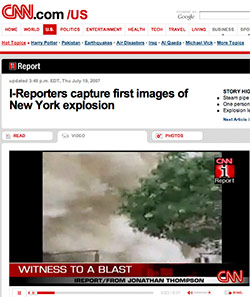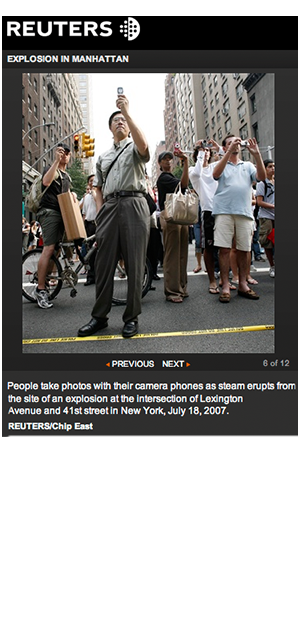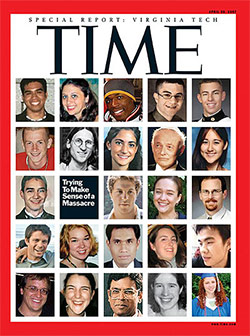Unvarnished Reality
 For awhile now, many of you have written in the comments, and to me privately, about just how "photojournalism is dead", or some variation thereof. In many cases, you're right. However, for those who set their own terms, specify what they are (and are not) willing to accept for any given assignment, and otherwise chart their own editorial course, work can be highly satisfying and lucrative.
For awhile now, many of you have written in the comments, and to me privately, about just how "photojournalism is dead", or some variation thereof. In many cases, you're right. However, for those who set their own terms, specify what they are (and are not) willing to accept for any given assignment, and otherwise chart their own editorial course, work can be highly satisfying and lucrative.
In a departure from my normal musings, I am presenting, with permission, highly regarded attorney and friend of many a photographer, Ed Greenberg's thoughts on this subject, and I commend it to you for serious consideration. Ed uses, for example, the recent events of New York where a steampipe burst, but the news outlets thought (and rightly so) that it just might be a terrorist incident, and as such, turned to "citizen journalists" for coverage. As a part of the discourse, where Ed's commentary and criticism of these activities by news outlets appears, I've presented the evidence of those points, and penned the sidebar commentary on this "new world order", created by (among others) Reuters, who has adopted the citizen journalist model.
Wednesday, July 18, 2007, ought to go down as the date that traditional bread and butter, editorial photojournalism manifested to anyone who chooses to see, that the profession is on life support. For years my mantra has been, “You can’t compete against free.” The traditional employers and clients of photojournalists have been newspapers, magazines and television who, I have argued, have been phasing you out of your livelihood.
For articulating that point of view, with a considerable amount of vigor, I have been vilified and attacked professionally and personally. Many well intentioned shooters have suggested that photographers ought “partner” with their traditional clients in order to assure their existence in the new media economy. That position is in my view naïve and tantamount to economic suicide.
So now a massive steam explosion occurs in Gotham’s midtown, super busy district during the middle of a work day some 75 yards from my former office. The resulting 400 degree steam geyser rising hundreds of feet into the air, just one block from Grand Central Station and literally on top of several subway lines, results in city blocks being closed off, subways turned off, a cacophony of emergency sirens continuing through today, one death, thirty injuries and of course thousands of photo opportunities.
 Within seconds to minutes of the explosion the local television channels were actively soliciting video tape, cell phone footage, still imagery and equivalents from the public for the expressed purpose of reportage. Websites, particularly gothamist.com featured “live coverage” employing un-credited “live” footage of the steam geyser. The publisher was on NPR this morning expounding with great clarity how she was effectively able to beat out the coverage of the New York network affiliates by using images freely sent to her. The images were and are more than adequate (take a look). The site paid zilch, zero, nada for the footage.
Within seconds to minutes of the explosion the local television channels were actively soliciting video tape, cell phone footage, still imagery and equivalents from the public for the expressed purpose of reportage. Websites, particularly gothamist.com featured “live coverage” employing un-credited “live” footage of the steam geyser. The publisher was on NPR this morning expounding with great clarity how she was effectively able to beat out the coverage of the New York network affiliates by using images freely sent to her. The images were and are more than adequate (take a look). The site paid zilch, zero, nada for the footage.The local Fox affiliate virtually begged on air for free images and gave instructions how to download or otherwise get the images to Fox for broadcast. Fox was not alone in the media world. We are unable to ascertain the number of images which ran in the NY Post, Daily News and NY Times which were shot by the many “civilian” employees who were evacuated from their offices and hit the streets with cellular phones held high over their heads in camera mode.
 Those print photo credits which do appear may be misleading as one or more agencies no doubt purchased images from unsuspecting amateurs outright. This practice pre-dates the oldest reader of this post. We do note that of the nine photos which appear in the tabloid NY Post of Thursday, July 19, 2007, not a single one bears a NY Post photo credit nor indicates that the shooter has any staff affiliation with The Post.
Those print photo credits which do appear may be misleading as one or more agencies no doubt purchased images from unsuspecting amateurs outright. This practice pre-dates the oldest reader of this post. We do note that of the nine photos which appear in the tabloid NY Post of Thursday, July 19, 2007, not a single one bears a NY Post photo credit nor indicates that the shooter has any staff affiliation with The Post.My confidential and unimpeachable photo source at the NY Post just told me that:
1. No staff photography (of the 9 subject images) was used;
2. Most images were "civilian", others were civilian purchased/acquired by agents/agencies;
3. Citizen shooters and journalists are now considered part of the newsgathering process and especially when lots of images from different sources flood the newsroom, little to no fact checking takes place. I inquired about how the use of particular lenses could “accurately” distort a news event and when it’s an amateur photo - how would the publication know? He/she laughed and laughed and laughed. "Hey Greenberg, are you f**king kidding me?"
 Client Adrienne DeArmas, working for Time Magazine on the Virginia Tech massacre story, was unable to procure/arrange for the creation of images that could compete with the Myspace and Facebook images of the students killed, their friends, families and teachers. The cover of TIME that week was a grid of said photos, with not one professionally shot image among them.
Client Adrienne DeArmas, working for Time Magazine on the Virginia Tech massacre story, was unable to procure/arrange for the creation of images that could compete with the Myspace and Facebook images of the students killed, their friends, families and teachers. The cover of TIME that week was a grid of said photos, with not one professionally shot image among them.The days when a significant number of skilled, staff editorial photographers were needed by newsgathering publications are over. Those of you who still believe that you can “partner” with your clients/enemies in order to assure your continued business existence are, with all due respect, hopeless. With no intention to disrespect any of the fine photojournalists who still work staff – many of whom we represent – the days of being able to support you and your family by hitting the streets and covering stories for newspapers are over.
Your clients beat you at your own game. You willingly cede your intellectual property rights to your clients who, simultaneously and with great calculation, enlisted the willing support of civilians who “charge” free. They have effectively rendered you obsolete.
Ironically, it is the news outlets and not the photographers who have truly mastered the art of digital photography. They have effectively rendered you obsolete.
You need to establish alternative and creative income streams. You need to bring something to the editorial table that Bernie the dentist who shoots for fun can’t. You need to treat this business as a business. You can’t let yourself be bullied into giving up your rights in a pointless effort to compete with “free”. You must be a business person first and an artist second. The handwriting has been on the wall for years. This episode is reflective of yet another battle lost in a war against photographers that was won by your friendly “clients” years ago.
I will be pleased to appear at any legitimate venue to discuss or debate any teacher, professor, photographer or photo professional who trains and represents that there is an economic future in photojournalism. Will some truly great photojournalists survive? Absolutely. No doubt. Does it however, make any economic sense to represent to any student or newbie that he has a realistic chance of being able to support a family at a middle class life style now and in the future by shooting traditional photojournalism? No way.
I am pleased to consider rational opposing views.
Very truly yours,
EDWARD C. GREENBERG
Edward C. Greenberg, PC
570 Lexington Ave.
17th Floor
NYC NY 10022
212 697-8777
ecglaw@aol.com
Please post your comments by clicking the link below. If you've got questions, please pose them in our Photo Business Forum Flickr Group Discussion Threads.

10 comments:
Cute as a button
From a practical point of view, there is something to be said for using the images by so-called citizen journalists, to cover some hard news events. A passer-by with a camera-phone who comes across an incident as it happens and manages to snatch a snapshot picture, is likely to be there before a staff photog could be dispatched to the incident. The image they get may well be inferior in quality, but it exists, and is available to be used.
This is a valuable resource to the newspapers, in these situations, but all such pictures are is snapshots.
Bernie the Dentist can take a snapshot of an explosion shortly after it happens in the street. He has the advantage of happening to be there and having his camera phone with him as it takes place, but how would he cope with the task of illustrating more involved photo-stories or features?
A photojournalist's skill never did stop at just having the technical ability to take a photograph of something happening. There is also an acquired ability to tell a story, to sensitively pick out the details in a whole scene and to work with the people who are caught up in the event, perhaps to find an alternative angle.
There is also still a place for the great skill technical skill of taking strong, creative quality photographs.
The image used to illustrate the article, which shows passers-by using camera phones to photograph the incident on Lexington Avenue, is credited to Reuters photographer Chip East. The photojournalist has found another angle to the story by showing that the passers-by are unfazed by the potential danger of the steam, and are keen to stop to take pictures.
Most people these days can write and use a word processor, but that dose not make them a writer or journalist, and dose not give them the skills they need to create a literary masterpiece, or produce a balanced and un-defamatory article.
The same thing must apply to photography, mustn't it? Surely a quality publication will always hope to first illustrate their pages with dynamic, strong, visually interesting and informative quality pictures, before resorting to fuzzy, badly composed and irrelevant camera phone images?
There are now many ways for your average Joe (or Bernie) to partake in the media. Joe can make films, and upload them to Youtube, Bernie can blog, and I can write comments on blogs!
I see this as little threat to TV, film, or the writing of book or magazine articles.
The accessibility of these mediums to the general public is an interesting cultural phenomenon, but as long as the viewing public has standards and tastes, and the need to be inspired by quality, there will always be a demand for skilled professionals in these fields.
The use of the copied images of the Virginia Tech victims on the Time cover, is not unusual or new.
Publications have always needed to use copied or sent in images of people who are no longer around to be photographed, to illustrate tribute articles. While it dose mean that a photographer was not commissioned to shoot the cover on this week's edition, this shouldn't be seen as a threat to the industry, because a new image wouldn't have been a viable option in this case.
Jonathan, you are missing the point. The whole point of the writer is to get across to you, that the celltographers ARE doing your job, and that their work IS being treated as if it were legitimate journalism/photography. Beyond that piddly little detail, I have a stronger question. This one is for Dave, and is in no way shape or form meant to be combative, or inflammatory. Dave, do you feel that you are somehow working to perpetuate this state with the site that you are running, which I might add is free? You are teaching something that has been in the past , considered by many (including myself) to be a black art? Something that one needs to go to school for, not something that can be felt. I have learned more about photography from your site than I could ever hope to learn from a school. The end result, I have bought seven thousand odd dollars worth of camera equipment, and am being considered for a job in the media based solely on my skill. Isn't this what the elite is afraid of? One amateur having the determination to bridge the boundary to Pro? And while we are at it, what makes a Pro? I have seen plenty of amateur shots that look professional, and I have seen more than enough "pro" shots that look worse than mine did when I started with a Powershot A80. Like all other things, this is a field where you must adapt and overcome. People want new, refreshing things. We have to find the combinations. I will use as an example the first thing that anyone shoots with a macro lens. A flower. Yeah it is really purty, but how many flower shots does it take. Google "flower macro" See how many results show up. I got 2,380,000! That is a lot of shots. Try this one "cute puppy" 3,720,000. One has to look past all the other stuff and find a creative insight, one that will set their images apart, and make them noticeable. Framing, and lighting are the two most key elements. Any idiot can make a proper exposure. I have a $2000 camera that will do it for me. It is however, hard to make all of the elements come together. It is a brave new world. Information is more than prevalent, it saturates the very fiber of our existence. It is up to us as photographers/photojournalists/
artists/professionals to use our better and superior understanding of the elements that comprise our trade to ensure our survival. Perhaps we should guard the information that we have on these elements a little more closely. Before I digress, I will make a point. I have watched the comments on the strobist site very closely. It seems that there is a very small gathering in the group that knows what Dave is talking about, but the majority are always scratching their collective heads. These head scratchers are not pro's, but people like me that came here to learn how to do this sort of thing, with no schooling backing them. If you are afraid for your job, perhaps this is not something to teach. It made a pro out of me. Jut one more person saturating the market, and vying for recognition. I asked a friend that has been shooting for 15 years about this site, and he told me that it was a great source, but I should have already known how to do a lot of this stuff. Since I have been making butchered shoe cords, I have seen almost all of these principles used in his work. All that he lacked was the technical know how to make a 20' shoe cord without a bunch of the stuff that MPEX has. I figured out how to do it with $18 dollars worth of stuff from Wolf Camera. Getting off track, the point is merely thus, The world is changing, move with it or go extinct.
Ed
I agree with you, and I too have been ripped by my colleagues by predicting; as you have been doing, that the death of photojournalism is almost upon us.
I wish my feelings about this were wrong; but I've seen many changes in the groups of photojournalists that work in the city where I work, and this change is occuring in at a rapid pace.
Where there were once numerous photographers working for magazines, newspapers, and for wire services; there are now less than 1/2 left. I'm sorry to say that this is really dishearting. It seems that the powers that be have decided to use more freelancers and SPEC shooters and the days of the contract photographer and staffer are pretty much over.
This leaves a void that is going to filled by whom? Well I'm almost certain that It's not going to be someone with many years experience who charges over $250 per day, because the agencies and other outlets are not going to pay anywhere near that much. So how how does a professional photojournalist afford to live on less than $250 per day with maybe 1 to 3 days shooting during the week if they are lucky?
This is the question that I need to have answered, how do I make a living as a photojournalist when there are people on the street willing to do this for free?
I have been saying for the last five-years we are watching the death of professional photojournalism and newspaper/magazine photography and this just confirms that feeling. It doesn't take a rocket science to figure that out.
I believe most of it has to do with papers and magazines trying to cut cost without consideration to quality or credibility of their product. How quickly these editors, managers and publishers have forgotten the powerful picture that professionals have brought to them in the past that made their papers or magazines.
Funny that I see this entry today. Today's LA Times front page images much be one of these freebie images. I saw it and thought to myself "What an awful image, must be a screen grab off some YouTube feed. Wonder why they couldn't get a real photographer there." It shows that the new standard is no standard at all--just use whatever drops into their laps and is free. The editors seem to have forgotten the maxim "You get what you pay for."
Why should photographers be immune from the same "cheap is good" crap that any other craft has had to deal with since the industrial revolution?
How many of us own hand-made furniture or clothes made by an independent craftsperson working on contract? Not even 10% of the population I bet.
Undoing that trend is going to take a cultural revolution that seems to be the opposite of where most consumers want to go. And I doubt most people who read the paper are likely to care where the images came from, any more than most of us are willing to only buy the items of our daily lives from sources that support individuals rather than the companies that profit from buying their work at the cheapest source.
Again I am not saying NO ONE cares about these issues, just that the issues that affect photojournalism are the same general ones that affect any craft. If you want to survive as a craftsperson (substitute "artist" if you like) you have to find your market and follow it as it changes.
Look for niche markets and developing trends and carve out a space for yourself or you're done, whether you're a photographer, painter, or cabinet maker.
This will be all fine and dandy until someone decides to hack the system on a real scale.
Someday, somewhere, someone will stat creating fake images that papers/TV will grab and sell under. Only after some time, will it be noticed and then an uproar will arrive, by that time it will be too late. What little credibility left will be lost.
As to someone coming into this field this late in the game.. I do not think it is a bad idea. Here is why, simply Chaos creates opportunity. For the old, well there never was a promise of life time employment, this is after all not a works program.
For you new kids, well you have time in your favor to make something good out of this. Again Chaos breeds opportunity and change, that is your "IN."
Chris P
I don't believe citizen photojournalists will hurt staff positions at all. You need staffers to cover the things citizens could never cover such as features, illustrations, longer term stories, etc....I'm more worried about the overall news industry and its impact upon journalism jobs. I've seen more photojournalists cut from the staffs due to papers losing readership and advertising. And with more and more citizen photojournalists sending in photos, won't the industry call for more photo editors to sort through them all? I'm not worried about the citizen sending in photos. It will actually help our industry. I'm more worried about the citizen never reading the news at all. Of course, if you're a freelancer for a major daily paper you better not rely so much on your spot news making you your money anymore.
Post a Comment